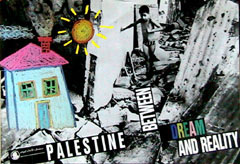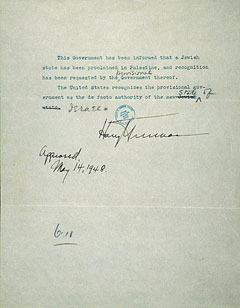Palestine:
Between Dream and Reality
Artists: A. Zulfikarpasic and M. Mikanovic (Yugoslavia)
Dimensions: 26.5” x 18.5”
Publisher: NGO Center for Solidarity With the Palestinian People
Circa 1988
The image in this photographic poster shows a young Palestinian boy,
clad only in a bathing suit, picking his way gingerly through the rubbish
and debris that litters the alley near his dwelling in some anonymous
refugee camp in the Middle East.
Sketched in on the left over the ruins of a wall is a chalk-like drawing of an idyllic, sun-dappled home. The unsubtle intent of the artist is to draw our attention to the disparity that exists between this boy’s dream of one day living in such a house in liberated Palestine and the alien, stateless slum that is his reality.

Approximately 4 million Palestinians have been exiled, internally displaced, or made homeless since 1948 when the British withdrew from Palestine and hostilities between the Israelis and Palestinians first erupted. The first refugee camps were built as temporary shelters for the dispossessed civilians. This poster was created in 1988, some forty years later. Another fifteen years have passed since, and the conditions inside the refugee camps today are, if anything, worse than depicted here. More people are crowded into them and what little infrastructure exists is slowly collapsing due to a dearth of funding for basic maintenance and physical damage resulting from Israeli military actions.
Not surprisingly, these horrific camps are breeding grounds for angry, desperate Palestinians who turn to militancy and armed struggle. Yet many Americans are baffled by this response.
The Palestinians living in these camps are part of the greatest and longest-running refugee crisis in human history. It poses a vast moral dilemma for the U.S., owing to its central role in the creation of the state of Israel and its ongoing status as Israel’s protector and benefactor. Yet many Americans are ignorant of their country’s involvement, which dates back to 1948 when President Harry S. Truman signed an executive letter recognizing the state of Israel. U.S. political and military support for Israel has been a feature of every American administration since Truman’s and the publicly available figure for current U.S. aid to Israel is approximately $4 billion per year.

Harry Truman's 1948 executive letter [enlarge].
American policy also gives unconditional support to Israel’s controversial right of return, which allows any Jewish person, living anywhere in the world, the right to settle in Israel — that is, to claim for himself or herself land that the Palestinians in the refugee camps claim is theirs. This unique provision perpetuates and exacerbates the crisis.
Curiously, none of the cause-and-effect social lessons from U.S. history have helped Americans understand the Palestinian perspective. They grasp the connection between the Western expansion movement of the late 19th century and violent resistance by indigenous Americans, between racial oppression and urban riots, between U.S. strategic bombing of Vietnam and acts of mass civil disobedience, between poverty and crime. Yet they have difficulty recognizing the cause-and-effect relationship between Israeli occupation of Palestine and the emergence of a Palestinian resistance movement. They prefer, it seems, to accept the image of Palestinians as irrational, wanton, and incapable of compromise. These unfortunate, parochial, and inaccurate perceptions serve Israel’s long-term agenda.
American blindness is a direct result of miseducation, according to the late Edward Said, a renowned professor of literature at Columbia University and a Palestinian American. He argued that Americans have been schooled by Zionist hasbara (Hebrew: Israel advocacy) to believe about Israel “that it was given to Jews by God, that it was empty, that it was liberated from Britain, that the natives ran away because their leaders told them to, that in effect the Palestinians don’t exist except recently as terrorists, that all Arabs are anti-Semitic and want to kill Jews.” Tragically, these beliefs have filtered into the unexamined thinking of the general American population.
Said continues:
Nowhere in all this incitement to hatred does the reality of a Palestinian people exist, and more to the point, there is no connection made between Palestinian animosity and enmity towards Israel and what Israel has been doing to Palestinians since 1948. It’s as if an entire history of dispossession, the destruction of a society, the 35 year old occupation of the West Bank and Gaza, to say nothing of massacres, bombardments, expulsions, land expropriations, killings, sieges, humiliations, years of collective punishment and assassinations that have gone on for decades were as nothing, since Israel has been victimized by Palestinian rage, hostility and gratuitous anti-Semitism. It simply does not occur to most American supporters of Israel to see Israel as the actual author of specific actions done in the name of the Jewish people by the Jewish state, and to connect in consequence those actions to Palestinian feelings of anger and revenge.
From: “Crisis for American Jews,”
New York Magazine, May 2002
While most Americans remain unfamiliar with the roots of the Palestinian-Israeli conflict and the Zionist creed that lays Biblical claim to the promised land, that cannot be said of the Palestinian boy in this poster. Like all Palestinian children in diaspora, he has undoubtedly been schooled in Zionist history and philosophy as well as in the countervailing historical perspectives of his own people.
With the signing of an executive letter containing only forty-two words, President Truman helped bring into being the state of Israel. He believed at the time that he was acting in the interests of, and according to the best humanitarian traditions of, the American people. He did not know that by helping to fulfill a dream of the Jewish people, he laid the groundwork for the creation of an existential nightmare for the Palestinian people and an indelibly shameful burden for his own.
© 2003 Liberation Graphics. All Rights Reserved.Questions for A New
Democratic Discussion
1) What challenges are posed by living in refugee housing — to physical and mental health, to education, to employment, to recreation?
2) What would prevent a family, living in the deplorable conditions found in a refugee camp, from simply packing up and leaving?
3) Imagine yourself being displaced from your home and blocked from returning there. At what point would you give up the hope of returning?
4) In 1964, the presidential campaign of Lyndon
Baines Johnson produced a highly provocative and effective 30-second TV
commercial. The purpose of the ad was to suggest that, if elected, the
other candidate (Barry Goldwater) would lead the nation to nuclear war
with the Soviet Union. The visual was a little girl plucking petals from
a daisy and the audio was a missile launch countdown. The commercial ended
with a burgeoning nuclear mushroom cloud. Why might artists choose to
include children in dramatic art of a political nature, as with that American
commercial and this Palestinian poster?
Please send us your questions and comments (English only please!)
www.liberationgraphics.com